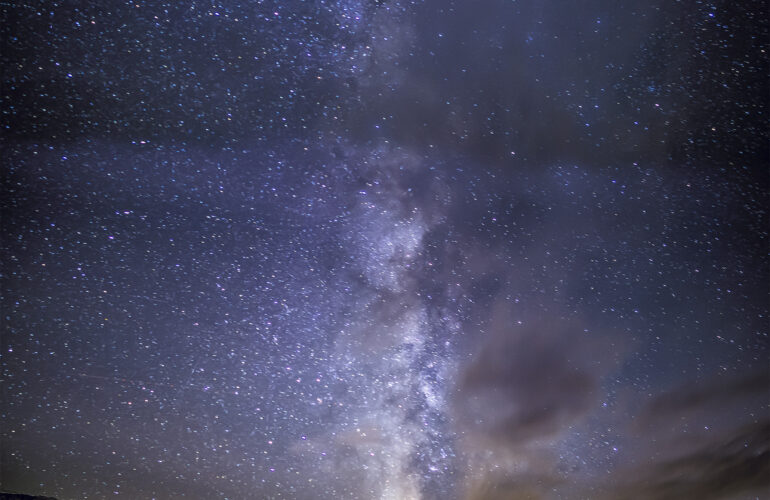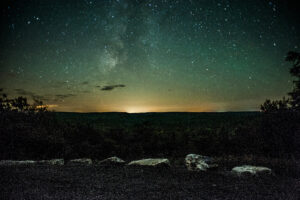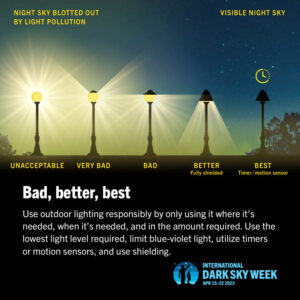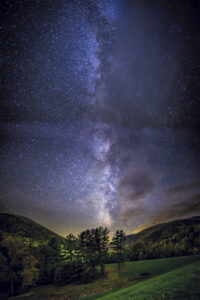
Pennsylvania’s Cherry Springs State Park (CSSP) has been renowned for its dark skies for well over 20 years, drawing visitors from the northeast and around the world to view the Milky Way and other astronomical objects under pristine skies.
What often is not well known is that Pennsylvania has other state parks with dark skies at levels approaching Cherry Springs. These parks may be much closer to your home and less crowded on new moon warm-weather nights.
Astro-tourism
Astro-tourism has been on the rise for about a decade worldwide. The popularity is understandable, given that it is estimated that 80% of the people in the US cannot see the Milky Way from their homes. Of the 20% who can, only a very small percentage live in an area with skies comparable to those found at Cherry Springs. Public locations with dark skies have been popularized by newspaper and magazine articles as well as social media. Darkskies International, formally the International Darksky Association, certifies dark sky sites based on light levels and light pollution mitigation efforts. Currently, Cherry Springs is the only certified site between Virginia and Maine. In coming years, additional Pennsylvania state parks may join Cherry Springs in this designation.
Areas such as the Pennsylvania Wilds region have benefited from the resulting tourism. It is reported that at times, nearly half the tourism information inquiries for Potter County mention dark skies as part of the motivation for a visit. As a result, these areas view their dark skies as a resource, and as such Potter County recently enacted legislation requiring responsible lighting on new construction.

Dark sky photo Frank Flores DelRosario Bald Eagle State Forest
Other Benefits to Dark Skies
While seeing the stars and increasing tourism is the obvious benefit of limiting light pollution, there are some less obvious ones. Wildlife and possibly plant life are impacted by light pollution. For example, foxes spend more time hunting during nights with less light—in a pristine environment, this would be around a new moon. If the sky is relatively bright around the new moon, they’ll save the effort they would put into hunting as they have less of an advantage is seeing potential prey.
Migrating birds are sometimes confused by illuminated structures at night and crash into them. During a single night in 2020, it was estimated that as many as 1000 birds may have flown into windows in a 4-block area of Philadelphia, at least partially due to night artificial lighting.
Light going directly into the sky from improperly designed fixtures serves no purpose and is one of the leading causes of light pollution. Recent estimates from the Pennsylvania Outdoor Lighting Council reported that as much as $6.2 billion per year was wasted on electrical power due to this.
What Makes for a Dark Sky Site
Areas of sky darkness are determined by three major factors, localized light pollution, regional light pollution, and weather.
Localized light pollution is readily controlled by relying on the five principles of responsible lighting, as outlined by Darksky International. Responsible lighting includes lighting that is useful, targeted, low level, controlled, and warm colored.

Dark sky infographic International Dark Sky Association
A visit to CSSP demonstrates these principles in action. Park lighting is only in areas where it is essential, for example at the entrances to the restrooms. These fixtures direct the light to the sidewalk, with no direct path to the sky or observing field. They are quite faint, and if your eyes haven’t had time to adapt, you may initially feel they are too faint. The lights are all red in color, which both limits light pollution and preserves night vision.
Large cities that are 50 miles or more away produce light domes that can illuminate areas of the sky nearer to the horizon. Regional light pollution stems from artificial lighting which can only be controlled by concerted action within these areas. Action to implement the five lighting principles over a region may require governmental legislation, although areas that reap the benefits of astro-tourism may achieve some results by voluntary means.
Weather, including atmospheric dust and air pollution, also has a significant impact on light pollution levels. Areas with high humidity levels, windborne dust, and aerosols from both natural sources and air pollution are much more prone to being impacted by distant artificial light sources. While air predominantly scatters blue light, these scatter light throughout the visible color range—resulting in a higher sky brightness. As weather is variable, a location’s light pollution levels can vary significantly even on clear nights.
Quantifying Darkness
There are several ways to determine the darkness of the skies at various locations. The easiest way is to access maps which show the Bortle scale of sky darkness.
This is color coded from white to black, with darker colors indicating darker skies. Here anything blue, gray, or black is very good. The Bortle scale is most often used on maps, and referring to one of these maps of Pennsylvania can provide information on which parks to consider for your night viewing.
Planning your first visit
In planning your first visit for a night sky viewing at a state park, first check their website for facility details, hours, and posted park rules. If it is a park that generally does not attract astro-tourists, it would be best to contact the facility manager and make sure night astronomy activity is welcome.
When looking at potential visit dates, you’ll want to look at moon phase and the park’s event schedule. Any park that regularly hosts astronomy enthusiasts will be busiest on new moon weekend. If you are only planning to observe the first part of the night, planning a trip around third quarter might be a good way to avoid crowds, but still not have any impact from moonlight. Visiting during a public star party might be a great way to spend your first dark sky night.
Also consider how the seasons impact what you can see in the sky. Different times of the year feature different areas of the sky in primetime before midnight. For example, if your goal is to see the brightest part of the Milky Way, planning a visit in spring would require you to be awake until just before dawn. Late summer, after twilight ends, is the best time for seeing this.
As your visit becomes closer, start looking at the long-term weather forecasts so you can be prepared to decide on the visit. Note there are several very good astronomy weather forecasting websites specializing in cloud cover.
Some parks, for example Cherry Springs, have “know before you go” programs. These virtual programs tell you what to expect during your visit, and how to prepare for it. Check the park’s website for more information.

Dark sky photo Donna Schneider Sinnemahoning State Park
What to Expect to See
Understanding what to expect using your telescope under dark skies is important. Many people will see photographs taken at dark sky sites and assume that they’ll see a similar view with a modest size telescope. Unfortunately, directly viewing through a small telescope even at the darkest site will not produce the views that a camera can give. A camera can effectively collect light much longer than your eye, and as a result, it can show color variations. Generally, except for planets, you will not see colors—instead, everything will look gray. You will be able to see deep sky objects much better at a dark sky site—so trying to find some gaseous and planetary nebulae, and galaxies is a good goal. If you are a beginner, Messier list objects are a great way to start, as they include some of the brightest deep sky objects.
Pennsylvania State Parks to Consider Visiting
Some offer programming, while some are only by special request. Please contact the individual park for specifics prior to visiting. Here are some to get you started:
Moraine State Park, [email protected], 724-368-8811
Prince Gallitzin State Park, [email protected], 814-674-1000
Laurel Hill State Park, [email protected], 814-445-7725
Cowan’s Gap State Park, [email protected], 717-485-3948
French Creek State Park, [email protected], 610-582-9680
Promised Land State Park, [email protected], 570-676-3428
Rickett’s Glen State Park, [email protected], 570-477-5675
Greenwood Furnace State Park, [email protected], 814-667-1800
Wrap Up
Astro-tourism is rapidly growing in popularity and is a great way to enjoy the outdoors at night. Pennsylvania’s state parks offer many options, ranging from Cherry Springs’ popular observing field to parks with nearly as good skies closer to where you may live. Make the parks you use for the night skies aware of your interest, so they can plan facility updates to support these activities in the future.
Written by: Steve Conard, Pennsylvania Wilds Astronomy Club, www.paWILDSastro.org




